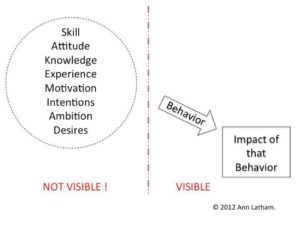 Would you like to be that person who silences chaos and moves things forward with a simple question or statement? I know you’ve experienced what I’m talking about. You’ve been there. Sitting in a typical meeting, wondering where things are going, wondering how to move things forward, and finally, someone breaks the logjam. With as little as one astute comment or question, the conversation is reframed, the confusion disappears, and the lightbulbs come on. Clarity triumphs over chaos. Suddenly, progress is not only possible but swift. Sighs of relief and smiles replace the knitted eyebrows and frustration.
Would you like to be that person who silences chaos and moves things forward with a simple question or statement? I know you’ve experienced what I’m talking about. You’ve been there. Sitting in a typical meeting, wondering where things are going, wondering how to move things forward, and finally, someone breaks the logjam. With as little as one astute comment or question, the conversation is reframed, the confusion disappears, and the lightbulbs come on. Clarity triumphs over chaos. Suddenly, progress is not only possible but swift. Sighs of relief and smiles replace the knitted eyebrows and frustration.
Admiring eyes turn to the brilliant creator of clarity. Some people openly express their gratitude. Several acknowledge to themselves that this is the reason he/she gets the promotions. And the ambitious wonder “Why can’t I be like that? Why can’t I make the brilliant comment that opens eyes and spurs productivity? Why can’t I stand out from the crowd with that kind of clarity?”
You can! The secret lies in making distinctions. Distinctions clarify and remove confusion. They reframe the conversation in two ways:
- One is by separating distinct issues and interwoven threads so the combined brainpower of the group can focus on one issue at a time instead of pushing and pulling against each other as the group tries to pursue multiple topics at the same time.
- The other is by interjecting distinct steps into a muddled conversation so complexity is replaced with a logical process.
Here are the top 7 distinctions you can learn to recognize, point out, and use to ask clarifying questions:
1. Objectives vs. Alternatives
When you make a decision, you must choose the best alternative relative to your objectives. That concept is easily understood and ought to be pretty straightforward. Unfortunately, most decisions start with alternatives, and objectives are raised only as pros and cons to support or counter an alternative. If you want to be brilliant, push for clear objectives before debating alternatives. Objectives are the decision criteria that should guide the decision. How will you know a good alternative from a bad one? You must be able to answer questions like:
- What are we trying to achieve?
- What factors are most important when making this decision?
Start with objectives and you will streamline the decision process, increase consensus, and make a better decision. Meanwhile, you will sound brilliant!
2. Strategy vs. Plan
A strategy and a plan are distinct. Unfortunately, they are often conflated at the expense of strategy.
A strategy is the framework of decisions that determine how you intend to play and succeed in the game of business or sustainable social improvement (see What The Heck Is A Strategy Anyway?).
A plan is a sequence of actions. In the context of strategic planning, the most critical actions are those needed for the organization to become capable of delivering on the mission and strategy.
Without this distinction between strategy and plan, strategic planning winds up being more about planning than strategy and often produces nothing but the next major To-Do list. Little to nothing occurs that transforms the capabilities and focus of the organization.
Practice separating the strategic thinking from the planning if you want a better strategy and a better plan. Meanwhile, you will sound brilliant!
3. Preventive vs. Contingent Action
Good planning includes both preventive actions, aimed at avoiding problems, and contingent actions, which prepare you for success even when dreaded problems crop up despite your best efforts to prevent them.
Plans fail. That is a simple fact. No plan of any consequence should proceed without considering what could go wrong and establishing both preventive and contingent actions.
Insist that potential problems are identified and then pursue both preventive and contingent actions. Without this distinction, no one will pause long enough to identify potential problems, never mind preventive or contingent actions. With this distinction, you will protect important plans and sound brilliantly omniscient in the process!
4. Goal vs. Transition
When developing strategic goals or just big, aggressive goals, there are usually people who balk because they can’t separate the goal from the efforts needed to achieve that goal. They can’t embrace the goal, no matter how wonderful, because they can’t see beyond the obstacles they will face in the transition. In other words, they are so worried about the ‘how’ that they can’t even talk effectively about the ‘what.’
Almost any goal can be achieved if the right people are committed to making it happen and backed by sufficient resources. However, anyone lost in the transition will never be able to think big enough to establish great goals, nor to make the commitment essential for achieving those goals. Instead, their comments and thoughts will be driven by fear and limitations. (For examples, see Clear Distinction: Vision vs. Journey.)
When you see this happening, you have another chance to make a brilliant distinction. Insist upon separating the goal from the transition. Note the fears and promise to deal with them and the transition at another time.
5. Process vs. Content
The content of any topic is the interesting stuff and the first place most people go. They want to express their ideas, defend their opinions, and hear what others have to say. But it takes a process to get from point A to point B without getting sucked into a free-wheeling, spiraling, treadmill conversation that can’t guarantee progress.
If you want to be brilliant, interrupt the content discussion and establish a process.
6. Characteristics vs. Behavior
 Debbie is devious, Andy is ambitious, Larry is lazy, and anyone who makes statements like these is asking for trouble. Why? Because these are assumptions about invisible characteristics. There is no way to know if someone is devious or ambitious or lazy or any number of other conclusions people make about other people all of the time. You may see something that makes you think someone is devious, but there could easily be another explanation for the behavior you saw. Making assumptions about other people is a bad habit. Furthermore, if you aren’t completely wrong, you are at least unkind, unfair, and/or insulting. (Want some examples? Take the Clarity Quiz: Which is Visible?)
Debbie is devious, Andy is ambitious, Larry is lazy, and anyone who makes statements like these is asking for trouble. Why? Because these are assumptions about invisible characteristics. There is no way to know if someone is devious or ambitious or lazy or any number of other conclusions people make about other people all of the time. You may see something that makes you think someone is devious, but there could easily be another explanation for the behavior you saw. Making assumptions about other people is a bad habit. Furthermore, if you aren’t completely wrong, you are at least unkind, unfair, and/or insulting. (Want some examples? Take the Clarity Quiz: Which is Visible?)
Enter the brilliant distinction! Separate the visible from the invisible and pay attention only to observed behavior and the clear impact of that behavior. This is the ticket to improving performance and resolving conflicts.
7. Awareness vs. Skill vs. Attitude
No one can be effective in any situation without appropriate:
- Awareness – the knowledge and understanding essential for effective action and judgment
- Skill – the ability to act
- Attitude – the desire to act
These conditions are distinct and critical. If someone’s performance is inadequate, don’t judge, berate, discipline, or coerce. Start at the top and, with the help of the individual, figure out what’s missing. I can’t tell you how often managers blame attitude when the problem is a lack of awareness regarding what to do, why, how, where, when, how well, and with whom. Use this distinction to brilliantly, and correctly, uncover the real barrier to better performance!
Go Forth and Make Distinctions!
The best way to learn to make distinctions is to start just by listening. As people talk, ask yourself whether they are talking about objectives or alternatives, strategy or plans, the goal or the journey, preventive action or contingent action, process or content, invisible characteristics or observable behavior, and awareness or skill or attitude. With a little practice, you will learn to hear the differences and then you will be ready to make those brilliant distinctions that open eyes, crush the chaos, and stop the whirlwind of activity trying to masquerade as productivity. In the meantime, there is one clarifying question that works in 99% of all situations: “What are we trying to accomplish?
Ann Latham is an expert on strategic clarity and author of The Clarity Papers.
Take The Clarity Quiz! Actually, take them all! Download a free copy of The Clarity Quiz Collection.
![]()
This article first appeared on Forbes, March 11th, 2018.


Comments are closed.